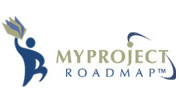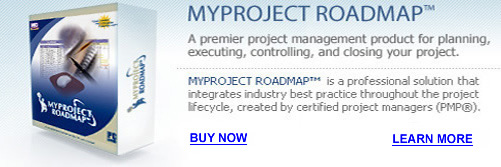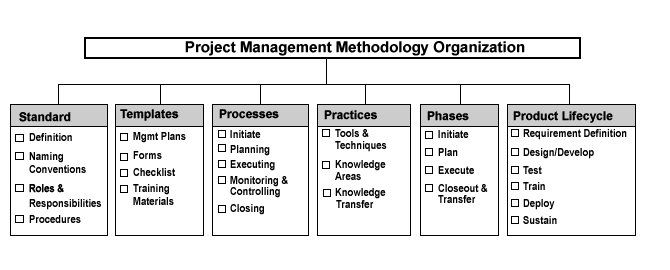
|
| |
 |
|
|
 |
 |
 |
| |
 PROJECT
MANAGEMENT OVERVIEW PROJECT
MANAGEMENT OVERVIEW |
 |
he field of Project Management
is innovative because each project is unique. Although the methodology
that is applied to each project is constant, the end results
produced by the project should be unique. The innovation in
project work is based on the creativity of the project team
to develop a solution under competing priorities (time, |
| scope, budget, legal
obligations, market demand, etc). Working in a project environment,
project teams have a unique opportunity to accomplish something
new each time they embark on a new project. Each project enables
the project team to apply their expertise on past projects to
produce a product that has intrinsic or tangible value to a
customer(s)--individual or groups of individuals. Although exciting,
project work has some real pitfalls that besets all project
teams at one time or another if they do not do their homework---upfront
planning. |
| |
|
MYPROJECT ROADMAP Project Management
Methodology Organization Illustration
|
|
|
| |
| Through years of
implementing successful projects, in both the public and private
sector, we have developed our approach to manage projects by
leveraging the ideals of the PMI® best practice and incorporating
it with Knowledge Management concepts and activities. |
| |
| Our goal is to provide
added value of focusing on the quality assurance process as
a foundation for the management of project deliverables. |
| |
| Program Management
is an integrated approach to the total management of projects
utilizing a best-practice project management process aligned
with the Project Management Body of Knowledge Guide (PMBOK Guide®)
by Project Management Institute (PMI®) and Knowledge Management
principles. |
|
|
| |
|
|
| |
In Project Management
there are five (5) Process Group categories: |
|
| |
| |
|
 |
Initiating |
 |
Planning |
 |
Executing |
 |
Controlling (Monitoring and Controlling) |
 |
Closing |
|
|
| |
|
|
| |
|
|
| |
| There are many individual processes that
a project can select to implement in order to increase the probability
of producing a successful project. The individual processes
are grouped into these five (5) categories called, "Process
Groups". Each Process Group category contains related processes
with associated activities that produces project collaterals
or will provide an input (something to be done or considered)
to another process to produce another project collateral (deliverable). |
| |
| Our approach to project management is based
on those processes needed to initiate, plan, execute, monitor
and control, and closeout projects with varying complexities
and sizes, to ensure that the technical and organizational interfaces
that will exist to guarantee the conformance and performance
to meet the project objectives across all project phases. |
| |
| A Project Phase is the approval of a logical
grouping of related or dependent deliverables. Each project
phase constitutes a very important milestone in the project
that is marked by certain deliverables (outputs). As the project
progresses, it will require specific actions and produce certain
deliverables either by the Project Manager and/or the Project
Team members. A Project Phase is marked by a review, such as
a Project Review Meeting, and approval of project deliverables. |
| |
| The process to develop a Project Phase naming
strategy is dependent on your or your company's orientation
to project management and on the project requirement, which
are based on industry-specific consideration. Your Project Phase
naming strategy may vary widely based on industry specific processes,
activities, and iterations of deliverables to satisfy the Customer's
expectation. |
| |
|
|
| |
Best-practice for a Project Phase naming
strategy includes the following activities: |
|
| |
| 1. |
Survey your organization
to understand the various types of projects |
| 2. |
Apply the same
Phase naming strategy for projects similar in type, complexity
and size. |
| 3. |
Group the activities
and processes related to produce a deliverable(s) into a project
phase. |
| 4. |
Identify critical
success factors for each process or activity and provide performance
indicators to compare actual project results. |
| 5. |
Specify the frequency
of iterations (repetitive) for each activities and processes. |
| 6. |
Identify resources
and roles related to the identified activities and processes. |
| 7. |
Using the Project Work Breakdown Structure,
separate each deliverable into its smallest component. |
| 8. |
Define the management approval levels
to make decisions at each project phase |
| 9. |
Obtain senior management buy-in. |
| 10. |
Encapsulate your
project management process around the total project lifecycle. |
|
|
| |
|
|
| |
| Project performance is determined
by comparing actual project results to performance indicators
that are defined in the Project Management Plan. The Project
progress evaluation is determined using these tools: |
|
|
| |
 |
Project Management Plan |
 |
Project Reviews |
 |
Performance and Audit reports |
 |
Project Status Reports |
 |
Team Member Status Reports |
 |
Project Defect Logs |
 |
Project Risk Register and Issues
Log |
 |
Plan for retention of Project records |
|
|
| |
|
|
| |
We have found many factors to deliver a
successful project: |
|
| |
 |
Obtain senior management
buy-in regarding your desired project management methodology |
 |
Work closely with
your project team and customer to identify the project management
process and project collaterals that are appropriate the project
based on the project objectives. |
 |
Identify and manage
functional & technical risks to the project/product scope
and quality throughout the life of the project. |
 |
Use expert knowledge
and past performance (historical information) to improve product
and process design. |
 |
Distribute your
project's resource assets according to the Project Work Breakdown
Structure and not a bundled response based on customer or management
pressure. |
 |
Communicate on
a regular basis with stakeholders throughout the project lifecycle. |
 |
Update formal acceptance
of all deliverables to ensure confirmation/validation of design
to requirements. |
 |
Monitor work results
continuously to compare project performance to the planned baseline
target. |
 |
Integrate Knowledge
Management practices into the project context and content. |
|
|
| |
|
|
| |
| Knowledge Management is a process and related
activities for companies to cultivate and retain information
produced within an organization. The objective of Knowledge
management is to enable an organization to achieve business
objectives, such as improve quality, produce better products
and services, by creating processes and activities to cultivate,
retain, and create new knowledge from experiences. |
| |
There is inherent synergy between
Knowledge Management and Project Management.
Simply, Knowledge Management ensures that a project will be
successful if the project team can create new knowledge, based
on lessons learned, widely communicate the new knowledge to
appropriate stakeholders, and promote an environment of shared
learning through knowledge transfer activities. |
|
|
| |
| |
| "PMI", "PMP", "PMBOK",
and the "PMP Logo" are registered trademarks of the
Project Management Institute, Inc |
|
|
| |
|
|
|
 |






